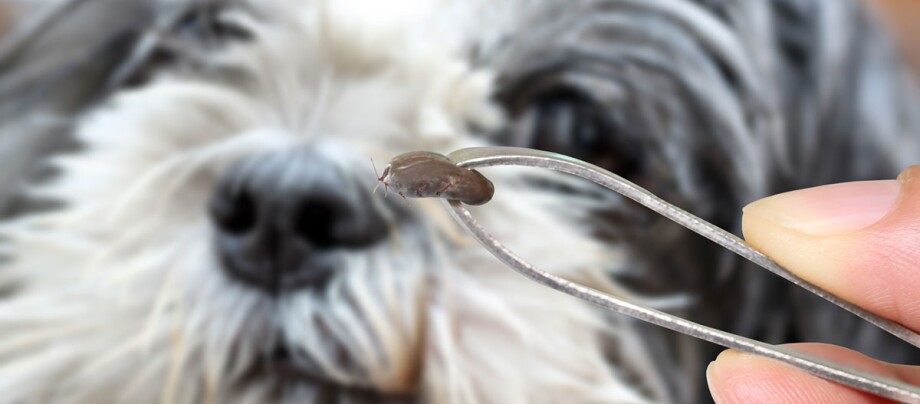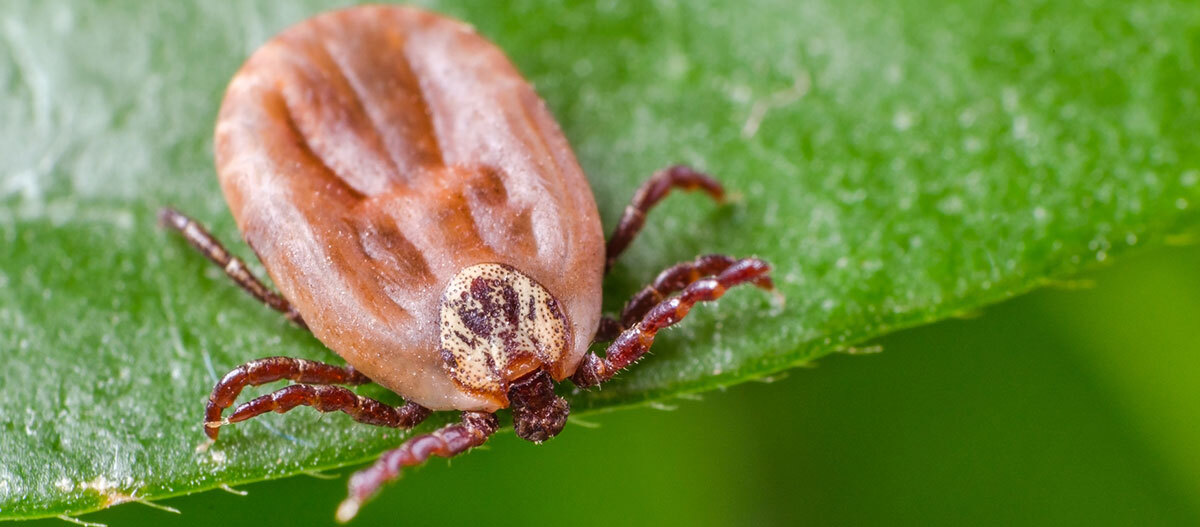Tick Bites on Dogs - How You Can Protect Your Four-Legged Companion
11.03.2025 - Reading time: 10 minutes

As the first flowers bloom and spring arrives, ticks spring back into action. It’s essential to ensure your dog is protected right from the start of the season. The common wood tick, alluvial forest tick, and brown dog tick lurk in tall grass and undergrowth, targeting dogs as their preferred hosts. A tick bite can transmit serious diseases to your dog, such as tick-borne encephalitis (TBE), Lyme disease, Babesiosis, Ehrlichiosis, or Anaplasmosis. Proper tick protection, vigilant observation, and emergency supplies will help you and your dog navigate tick season safely. Read our guide and keep your dog safe!
- Ticks and tick bites in dogs: How do ticks get on to your dog?
- What happens when a tick bites your dog?
- Ticks and diseases are on the increase: What do you need to be mindful of with tick bites?
- The brown dog tick and its pathogens
- The castor bean tick and its pathogens
- The meadow tick and its pathogens
- Important note
- What to do if your dog is bitten: tick tweezers, tick hooks and tick loops
- Holidays with your dog - protection against ticks when abroad
- Information graphic
Ticks and Tick Bites in Dogs: How Do Ticks Get on Your Dog?
As soon as the temperatures start to rise, the dreaded tick season begins. Ticks don’t follow a calendar; they just need a comfortable temperature of around 7°C to become active. If you live in a consistently warm area or are on holiday, then “tick season” can last all year round!
Ticks (Ixodidae) are arachnids and belong to the subclass of mites that feed parasitically on the blood and lymphatic fluid of their hosts. You can recognize them by their triangular, flattened body with eight long legs and a small mouth area. They range in color from dark brown to red-brown. Some species have a shield (hard-bodied ticks), while others do not have an exoskeleton (Argasidae).
If you closely examine a tick, you can clearly see its mouth, which have parts that are shaped like pincers at the end of its head. The actual piercing tool is hidden between these “pincers” and is used for feeding while also holding onto the victim. Thus, the term “tick bites” actually refers to the tick piercing through the skin.

andrei310/stock.adobe.com
Ticks go through several stages before they become fully grown. They lay eggs outside the host (e.g., on the dog bed), which hatch into larvae. These larvae develop into nymphs, which eventually become adult ticks. Ticks are active parasites during all three stages, biting dogs, humans, and other animals to continue their development. The larvae and nymphs are small and hard to spot, but adult ticks can be seen relatively well with the naked eye, provided your dog’s coat allows for easy viewing. Once the tick is full of blood, it will be easy to see, with its grey, bulging body. Fully fed female ticks can reach up to 3 cm in size.
Ticks prefer to live in locations like the edges of woods and forests, meadows, clearings, and parks. They sit on high grass stalks, low-hanging branches, and in bushes, reaching out with their forelegs equipped with special sensory organs to detect passing victims. They are alerted by odors (sweat), vibrations, and changes in CO2 levels (breath), allowing them to drop onto potential victims. Some tick species are active “hunters” and search for victims themselves.

K_Thalhofer / iStock / Getty Images Plus via Getty Images
Dogs are especially affected by ticks because they love to explore tick-prone areas. However, humans and other animals like cats, hedgehogs, birds, mice, rats, and sheep are also prey for ticks. Generally, ticks are specialized in specific hosts, and they have developed sophisticated anesthetics tailored to the immune systems of their specific hosts.
Once a tick lands on a dog, it searches for a suitable spot to bite, preferring thin-skinned areas that are well-supplied with blood, like the head, lumbar region, ears, and stomach. The fear of these bloodsuckers is justified because tick bites in dogs and humans transmit more pathogens than any other type of parasite, except for mosquitoes. Globally, there are around 900 species of ticks. In Europe, there are three main tick species: the wood tick, the alluvial forest tick, and the brown dog tick.
What Happens When a Tick Bites Your Dog?
Once a tick finds a suitable spot on your dog’s body, it scratches the skin with its mouth and inserts its proboscis into the wound. This is how it sucks lymph, cell fluid, and blood. Hard ticks have a long proboscis with barbs, which they use to latch firmly onto their host. During this process, the tick releases a secretion containing various active substances:
The secretion has the following active substances:
- An anesthetic to keep the feeding process undetected
- An anti-inflammatory to block the host’s immune system
- An anticoagulant to prevent the wound from closing and to ensure blood flow
- Ticks with a small, long proboscis with barbs release an adhesive substance to stick to the dog’s body
Ticks can harbor pathogens like bacteria, viruses, and other parasites, using the tick as an intermediate host. The tick may have contracted these cohabitants during a previous feeding from an infected host. While feeding, the tick releases undigested blood residues from its intestine into the dog’s wound, transmitting these pathogens and potentially leading to dangerous illnesses in the dog’s system.
A blood meal for an adult male tick takes a few days and is relatively small, as the male only needs the blood for its own sustenance while waiting for a female. However, adult females can suck at the bite site for several weeks, as they require more blood to produce eggs.
The risk of the dog being infected with pathogens begins after approximately three hours. The tick needs this time to disgorge the undigested remains of its blood meal, along with pathogens, into the host’s wound. The danger of infection increases with each hour the tick feeds on the dog’s blood. Therefore, it is crucial to remove the tick immediately upon spotting it on your dog! Learn more about this process here.
Ticks and diseases are on the increase: What do you need to be mindful of with tick bites?
Pathogens Transferred by Tick Saliva
Pathogens present in a tick’s saliva can cause some of the most serious illnesses in dogs and should be taken very seriously. In central Europe, the most dangerous ticks for dogs are the wood tick, alluvial forest tick, and brown dog tick. The brown dog tick, in particular, thrives in warm and dry conditions and has a strong preference for dogs.
The Brown Dog Tick and Its Pathogens
Previously thought to be native only to the Mediterranean region, the brown dog tick has proven to be viable in Germany and Switzerland due to global warming and the increasing number of imported dogs. The brown dog tick (Rhipicephalus sanguineus) is typically reddish-brown and ranges from 1-3 mm in size, with engorged females reaching up to 1.2 cm.

The entire life cycle of the brown dog tick—from larva (approximately 0.5 mm) to nymph (approximately 1 mm) to adult—takes place on the dog’s body. The floor and areas where the dog rests serve as egg depositories. These ticks are quite active, roaming through their host’s living spaces to “hibernate” and can survive up to a year without a blood meal.
The brown dog tick can transmit several dangerous diseases, including Canine ehrlichiosis (Ehrlichia canis), anaplasmosis (Canine Cyclic Thrombocytopenia), and babesiosis (Babesia canis vogeli). These diseases are among the most feared canine illnesses and are found at varying levels of prevalence throughout Europe.
Ehrlichiosis, also known as “tick fever” or “Mediterranean disease,” is caused by Rickettsia-type bacteria. These bacteria attack white blood cells (leukocytes) in the dog’s body, impairing the immune system. Symptoms of ehrlichiosis are diverse, starting with an acute phase that progresses to a subclinical, asymptomatic stage within two to four weeks, and eventually to a symptomatic chronic stage.
Look for the following symptoms of the acute phase (up to three weeks incubation time after tick bite):
- Fever and fever episodes
- Vomiting
- Fatigue
- Swelling of the lymph nodes
- Occasional muscle twitching
- Shortness of breath / heavy breathing
As ehrlichiosis has a silent stage it is not always recognised and tends to become a chronic illness. Babesiosis, from the species Babesia canis vogeli, runs a relatively mild course and is still rare in Central Europe, but is widespread as a cross infection with ehrlichiosis in the Mediterranean, France, North Africa and South America. See alluvial forest tick for information on babesiosis.
Anaplasmosis was counted as ehrlichiosis until recently. However, latest research has shown that the bacterial pathogens concerned with this disease are of the Anaplasma type. The symptoms are similar to ehrlichiosis.
At times the dogs do not show any visible symptoms apart from exhaustion. The Anaplasma bacteria attack special white blood cells – the granulocytes. The illness worsens through cross-infections with babesiosis and ehrlichiosis.
There are no vaccinations for all three illnesses, prophylaxis is done exclusively via tick repellents.
The castor bean tick and its pathogens
The common wood tick (Ixodes ricinus) is somewhat larger than the brown dog tick and transmits pathogens of Lyme disease, early summer meningoencephalitis (TBE) and anaplasmosis.
While dogs contract TBE very seldom, Lyme disease is the most common tick-borne disease in dogs in our latitudes.
Borreliosis is caused by the bacteria of the genus Borrelia and the incubation period is between two weeks and five months. The symptoms of borreliosis are non-specific in the early stages and gradually get worse.
Pay close attention to:
- Recurring fever, loss of appetite and exhaustion (early stage)
- Joint pain and inflammation
- Muscle pain
- Lameness of front and hind legs
- Heart problems
The main symptom is a kind of reddish rash around the puncture site but this is seldom noticed in the dog’s thick coat (or with dark skin pigmentation).
In severe cases, neurological damage may remain, or the disease may take a chronic course. In some cases it ends fatally for the dog.
A borreliosis vaccination does exist but it only covers a few of the possible Borrelia bacterial strains. It is not considered sufficient and requires an additional tick prophylaxis anyway.
The meadow tick and its pathogens
The alluvial tick (Dermacentor reticulatus) is somewhat larger than the wood tick and can be well differentiated by the whitish marbled spine with a reddish-orange outer edge. It transmits babesiosis pathogens, the Babesia canis canis, which lives in red blood cells (erythrocytes) and destroys them. Thus, first symptoms of this disease is anaemia (anaemia of the blood). Initially babesiosis was a “Mediterranean disease”, however, the pathogens have spread to Germany, the Netherlands, Poland and Switzerland. The pathogen is considered to be particularly strongly disease-causing. Babesiosis is also known as “dog malaria”. Untreated, it leads to the death of the dog.
In the beginning the symptoms are non-specific:
- High fever or bouts of fever
- General dullness and weakness
- Pale yellowish mucous membranes
- Red to green-brown urine
- Kidney failure
- Digestive and circulatory disorders
- Edema
- Central nervous symptom disorders
Please note
The information given in this guide is not intended to be a substitute for a visit to the vet. It should not be used as the sole basis for health-related decisions. A vet should always be consulted if your pet is unwell, and should give guidance on medication.
What to do if your dog is bitten: tick tweezers, tick hooks and tick loops
Checking Your Dog for Ticks
It’s challenging for dog owners to prevent their furry friends from exploring undergrowth, fields, and bushes, as these are a dog’s natural habitats. Therefore, it is essential not only to exercise caution but also to thoroughly check your dog after every walk, especially from March to October.
Conduct a thorough examination by carefully searching your dog’s fur for parasites. Start by brushing your dog thoroughly and then rub them with a white, slightly damp cloth. Be on the lookout for brown to reddish-brown mites or ticks firmly attached to the head, abdomen, groin areas, ears, and between the toes. If you find a tick attached, use a special device designed for tick removal. Remove the tick immediately.
At Maxi Zoo, you will find various tick removal devices, such as tick tweezers. Experts recommend tick hooks, available in two different sizes. These tools can efficiently and painlessly remove ticks from sensitive areas of your dog’s body.
Holidays with Your Dog: Protection Against Ticks When Abroad
When traveling abroad with your dog, it’s important to protect them from parasites and pathogens common in the destination.
Dog's Symptoms After Tick Bite:
- Bouts of fever
- Vomiting
- Loss of appetite
- Exhaustion
- Weight loss
Warning Symptoms:
- Yellow to bloody urine
- Movement disorders (ataxias) and changing symptoms of lameness
- Aching legs
- Bleeding and edema
If you notice these symptoms, take your dog to a vet immediately.


